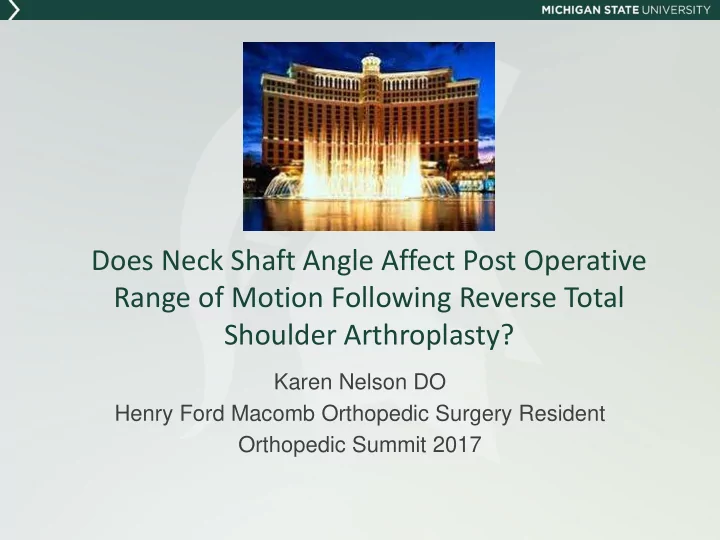

Does Neck Shaft Angle Affect Post Operative Range of Motion Following Reverse Total Shoulder Arthroplasty? Karen Nelson DO Henry Ford Macomb Orthopedic Surgery Resident Orthopedic Summit 2017
Disclosures None 2
Grammont Prosthesis “The patient who has lost a function doesn’t care about the design of the prosthesis that will be implanted, but only about its effectiveness in restoring the lost function. It is useless to search for an anatomic solution as this very anatomic system led to failure.”
Problems with Grammont Prosthesis Deltoid Tensioning and Instability Decoaptation • Symmetric- Unstable • Asymmetric- impingement on glenoid neck Subscapularis repair “Pistoning”- interposed hematoma (drains) Overtensioning- Acromial Fracture
Problems with Grammont Prosthesis Humeral Fixation Scapular Notching and Poly wear Deficient or Absent external rotation Limited lateral offset Medialization of humerus (decreased post. Deltoid) Less efficient Cuff/lack of teres minor Suprascapular nerve injury breaching cortex with posterior screw
Grammont Prosthesis 2 innovations Large glenoid hemisphere without glenoid neck Small humeral cup almost horizontal (155 degrees) • Less than half of glenosphere Main Idea Medialize the COR Decrease torque on glenoid Recruit more deltoid fibers Increase acromial-humeral distance
Reverse Total Shoulder Arthroplasty Joint replacement procedure where the ball and socket of the glenohumeral joint are reversed FDA approved in the US in 2004 7
Reverse Total Shoulder Arthroplasty The prosthesis design alters the center of rotation (COR) by moving it medially and inferiorly This increases the deltoid moment arm and tension Enhanced mechanical advantage of the deltoid compensates for the deficient rotator cuff Deltoid becomes the primary elevator of the shoulder joint 8
Goals of rTSA Pain relief Achieve functional ROM while allowing for adequate soft tissue healing Maximize the use of upper extremity for daily activities at or above shoulder height Educate patient/Compliance with post op protocol 9
Indications Rotator cuff arthropathy Pseudoparalysis (occurs secondary to irreparable cuff tear in the setting of GH arthritis) Antero-superior escape Acute 3 or 4 part humerus fractures in the elderly Failed arthroplasty (when all other options have been exhausted) Rheumatoid arthritis (only if sufficient glenoid bone stock) 10
Contraindications Deltoid deficiency (axillary nerve palsy) Bony acromion deficiency Insufficient glenoid bone stock Active infection 11
Our Study We retrospectively reviewed 22 patients Single surgeon study comparing preoperative and postoperative range of motion 2 groups Biomet (9) and Depuy (13) Inclusion criteria Patients with cuff arthropathy Any patient age or comorbidities No prior shoulder surgery Minimum 6 month follow up 15
Implants Depuy Delta Xtend Humeral inclination 155 degree Inlay Biomet Comprehensive Humeral inclination 147 degrees Onlay 16
Study Design We hypothesized that the patient with the 155 inclination would achieve better post operative ROM with forward flexion compared to their pre op ROM because the implant design lowers the COR and creates a longer lever arm for the deltoid We chose to focus on forward flexion given that it is the most functional plane of motion for ADLs 17
Methods All patients underwent a standard deltopectoral approach The subscapularis was repaired in all patients Average age in the 155 group was 71yo Average age in the 147 group was 73yo ROM was measured at pre op visit, then at 6 weeks, 3 months, and 6 months VAS and ASES scores were also collected at these visits 18
Methods: Post Op Protocol Patients were placed in an abduction sling after surgery and allowed passive ROM at the shoulder immediately post op. Active ROM at the 2 week visit. No active abduction until 6 weeks to protect the subscapularis repair. Sling discontinued at 6 weeks. PT was initiated at 6 weeks 19
Results Patients in the 155 group achieved an average of 53 degree improvement in ROM at 6 months Patients in the 147 group achieved an average of 40 degree improvement in ROM at 6 months There was no difference when comparing VAS and ASES scores between the groups 20
Conclusion Patients with the 155 stem achieved increased forward flexion when compared to the 147 group Patient recorded outcome scores and pain scores were no different between the 2 groups We are continuing to collect data for 1 and 2 year post op visits 21
Questions 22
Recommend
More recommend